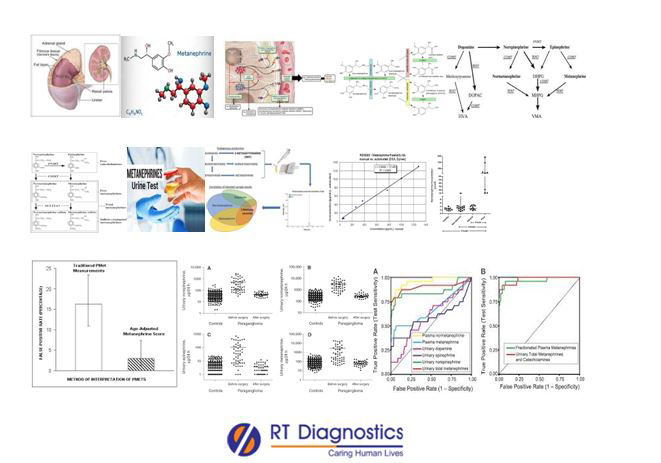Metanephrine :Urine
Why Metanephrine Urine Test?
CLINICAL INFORMATION
Catecholamines are hormones produced by the brain, nerve tissues and adrenal glands. The major role of catecholamine is to function as a neurotransmitter. The physiological function of catecholamines is to increase the heart rate, blood pressure, breathing rate, muscle strength, and mental alertness and it lowers the amount of blood flow (vasoconstriction) to the skin, intestines and to the major organs including the brain, heart and kidneys. These neurotransmitters sends a signal throughout the nervous system and thus help to regulate movement, emotions, memory and also in fight or flight response. Dopamine, adrenaline (also called epinephrine that allows increased blood flow to the heart, muscles, lungs etc) and noradrenaline (also known as norepinephrine which increases heart rate, blood pressure and is involved in mood regulation and ability to concentrate) are collectively known as Catecholamines (are released during stress response). Catecholamines are released into the blood when a person is under physical or emotional stress. Splanchnic nerve stimulation is the physiological stimulus for catecholamine secretion. The stimulation of splanchnic nerves results in the release of ACh from nerve endings in the adrenal medulla. Metanephrines are catabolic products of hormones called catecholamines. The enzyme COMT –Catechol–O –Methyl–Transferase degrades the catecholamines (the degraded metabolites are Vanillyl-MandelicAcid –VMA and other free catecholamines) are excreted in the urine and hence catecholamines in urine can be estimated in 24 hours urine specimen. Altered levels of catecholamines indicate certain pathologies (neuroendocrine tumour called neuroblastoma – cancer in specialized nerve cells) in the body, hence catecholamine tests or levels of metanephrines are tested. Hence this test also aids in the detection of pheochromocytoma (adrenal gland tumour) etc. Thus metanephrine urine screening test detects pathologies such as neuroblastoma, pheochromocytoma etc. Symptoms of neuroblastoma include abdominal bloating, abdominal mass, watery diarrhoea, small pupils, drooping upper eyelid, inability to sweat, high BP etc. symptoms of pheochromocytoma are palpitations, high BP, anxiety, excessive sweating, blurred vision, severe headaches, constipation, high blood glucose, tingling in finger and toes. Clinical manifestations of abnormal adrenaline include anxiety, palpitations, high BP, sweating, weight loss etc. Symptoms of low noradrenaline include low BP while standing up, ADHA, depression etc. symptoms of high noradrenaline include panic attacks, hyperactivity, high BP, irregular heartbeat, headaches etc. Symptoms of altered dopamine levels include excess saliva, nausea, ADHD, anxiety, agitation, insomnia, delusion, depression, schizophrenia, psychosis etc. Long term high levels of dopamine may be associated with Costello syndrome, leukaemia, Menke’s syndrome, and aromatic L-amino acid decarboxylase deficiency. Other additional tests include imaging studies such as MRI, CT Scan etc.

General Instructions:
Sample Requirement: Specimen - Urine.Test Preparation: None.
NOTE - Sample for specimen collections may vary based on the patient’s condition/cases according to the patient’s presenting complaints/signs or symptoms:
SPECIMEN REQUIREMENT (Special or Rare Cases) - As instructed and guided by Physician / Clinician / Pathologist / as per Laboratory’s requirements, according to procedures and protocols.
This Multi-Specialty Clinical Referral Laboratory RT DIAGNOSTICS provides precise and accurate tests with an extensive range of testing services to the medical centres to help in the diagnosis and identification of pathology in the test specimens for infectious diseases and also to evaluate the function of organ systems of the patient. It prevents further complications and helps to stabilize and restore health to near normalcy at the earliest without delay.



